Garden hoses make our jobs as gardeners infinitely easier, and can do so for years to come – when they’re properly cared for.
Even a beat-up, veteran one that’s served you well for a while now can have its tour of duty extended a bit longer with the right treatment.
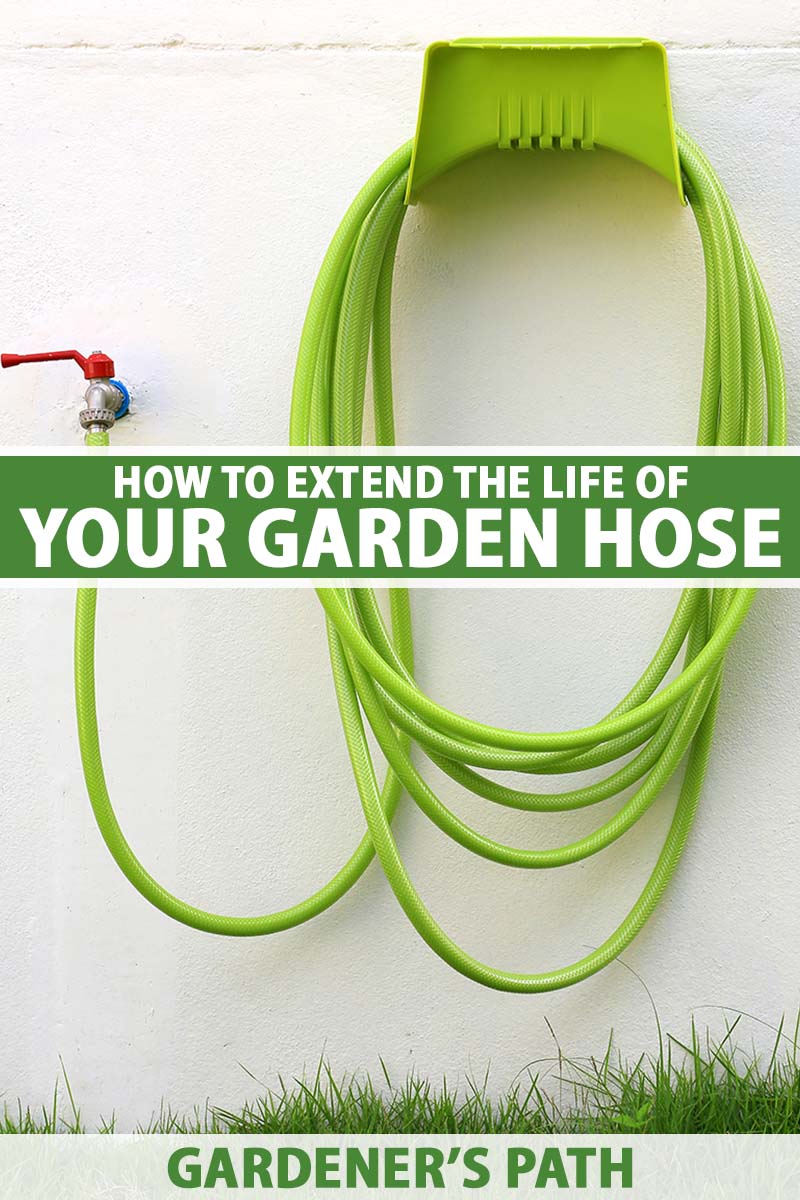
We link to vendors to help you find relevant products. If you buy from one of our links, we may earn a commission.
As a dude who’s put in more than a few hours watering thirsty landscape plants, I am extremely thankful for the humble garden hose.
Without it, us gardeners would have to make approximately a zillion trips with a bucket or watering can, each one leaving our legs splashed with enough jostled water to look like we’ve wet ourselves.
Or maybe that’s just me… it’s what I get for filling up to the brim, I guess.
Regardless, our garden hoses should receive all the TLC we can give, lest they break and force us to go back to those dark, “lugging-all-our-irrigation-around-like-Neolithic-farmers” days.
Which would be great for building up our traps and forearms, but kinda crummy for irrigating landscapes quickly.
In this guide, we’ll cover a brief hose primer, how to prevent damage, and how to fix said damage, if necessary.
We’ll also go over what to look for in a replacement, if acquiring a replacement ever becomes necessary.
Here’s a roadmap of where we’re going:
What You’ll Learn
Tips for Preventing Wear and Tear
When cared for and properly maintained, a well-used garden hose can last five to 10 years… or sometimes more! Let’s go over how to make that happen.
First things first – in gardening, it’s really important to know about the dreaded kink.
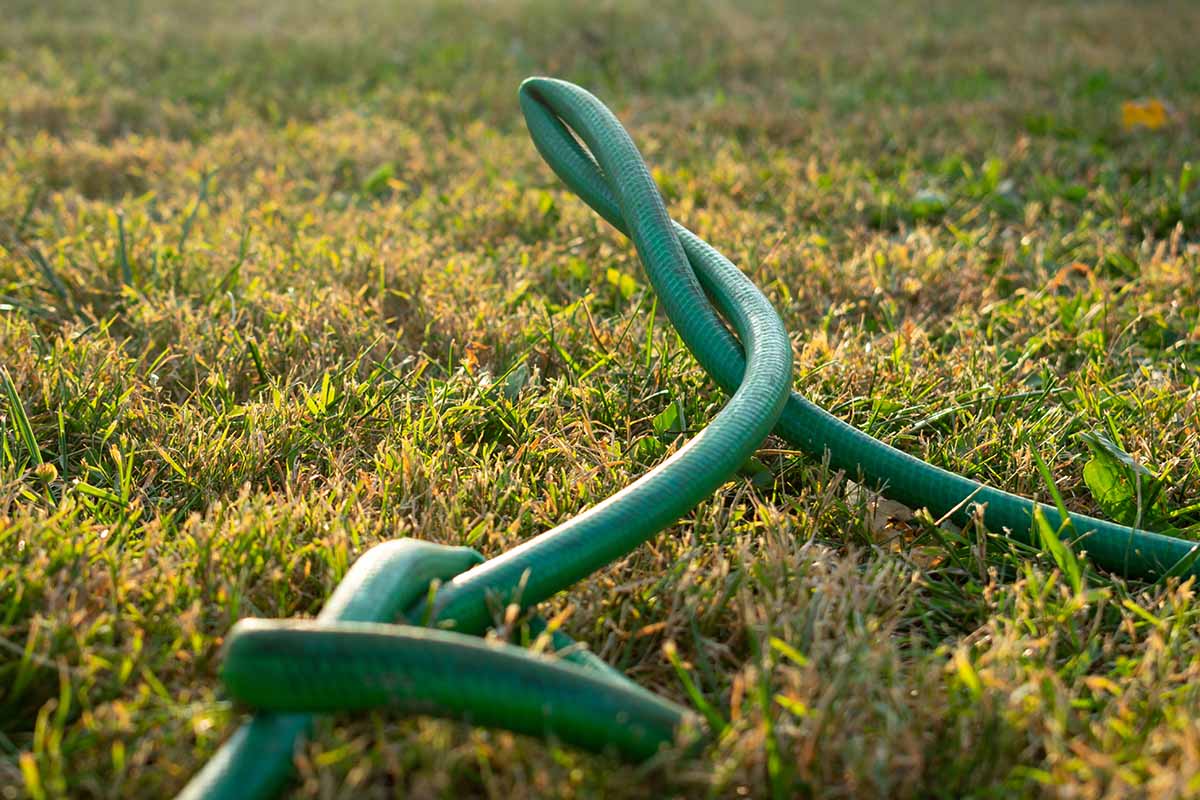
In a perfect world, tubing would remain perfectly untwisted, and gently curve as needed.
But as gardeners lug hoses around from plant to plant, they can sharply bend, twist, or otherwise become contorted with one or more kinks.
Once a kink forms, it becomes easier and easier for that kinked spot to re-kink in the future, kinda like a paper’s crease becomes easier and easier to fold over time.
And just as a strong crease can easily tear, an often-kinked section of tubing is at a higher risk of splitting.
Always be mindful of your hose’s position as you use it. Lay it out away from obstacles like building corners or tree trunks so it doesn’t snag on and sharply fold over them.
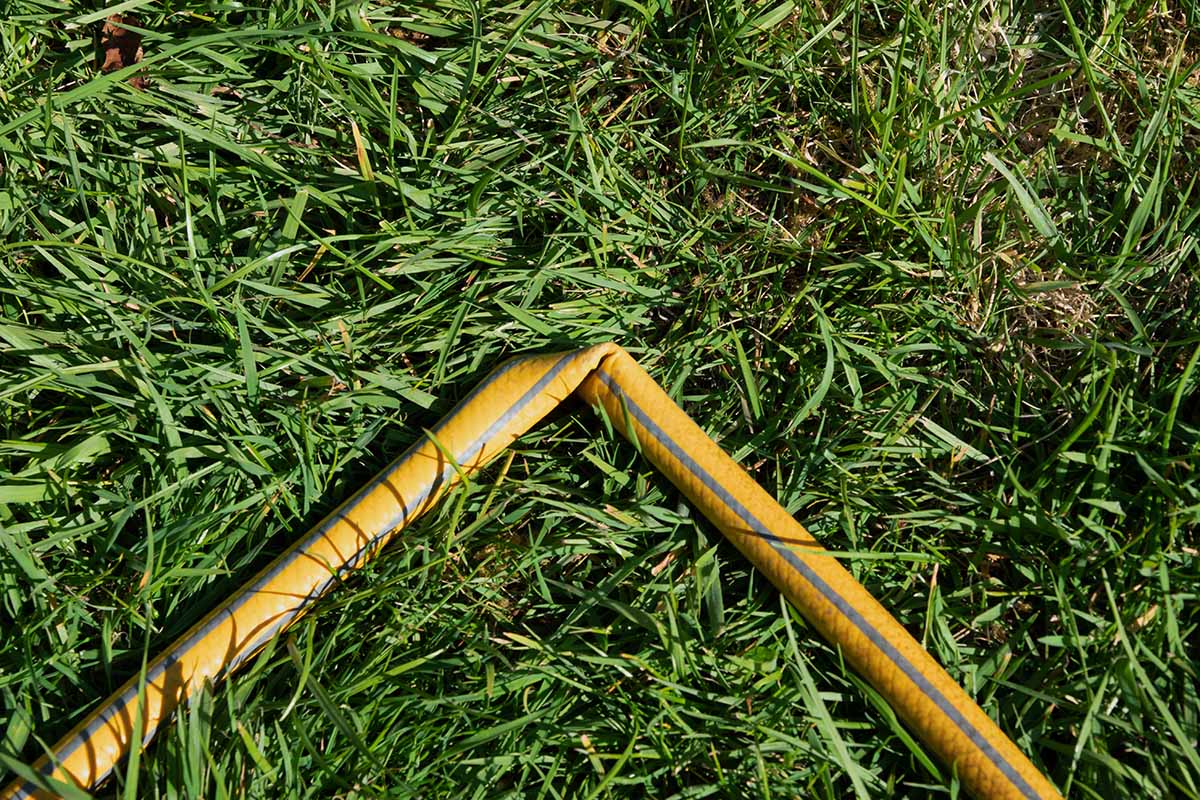
When unraveling from a coiled pile, gently orient the tubing in your hand in the direction that it wants to face, rather than straining it into a twisted position. If it feels like you’re forcing it one way or another, you probably are.
The same goes for re-coiling as well. Whether you opt to coil the tubing in a single looped circle or in a figure eight pattern, make sure to wind it up in the way that it naturally wants to go.
When hanging your coil, don’t rest it on a single, skinny anchor point, as the small surface area can lead to a kink of its own. Make sure to spread the weight out over multiple points of contact, or at least a single wide one, such as you might with a hose reel.
We’ve got an ample roundup of hose reels right here for ya if you’re exploring your options.
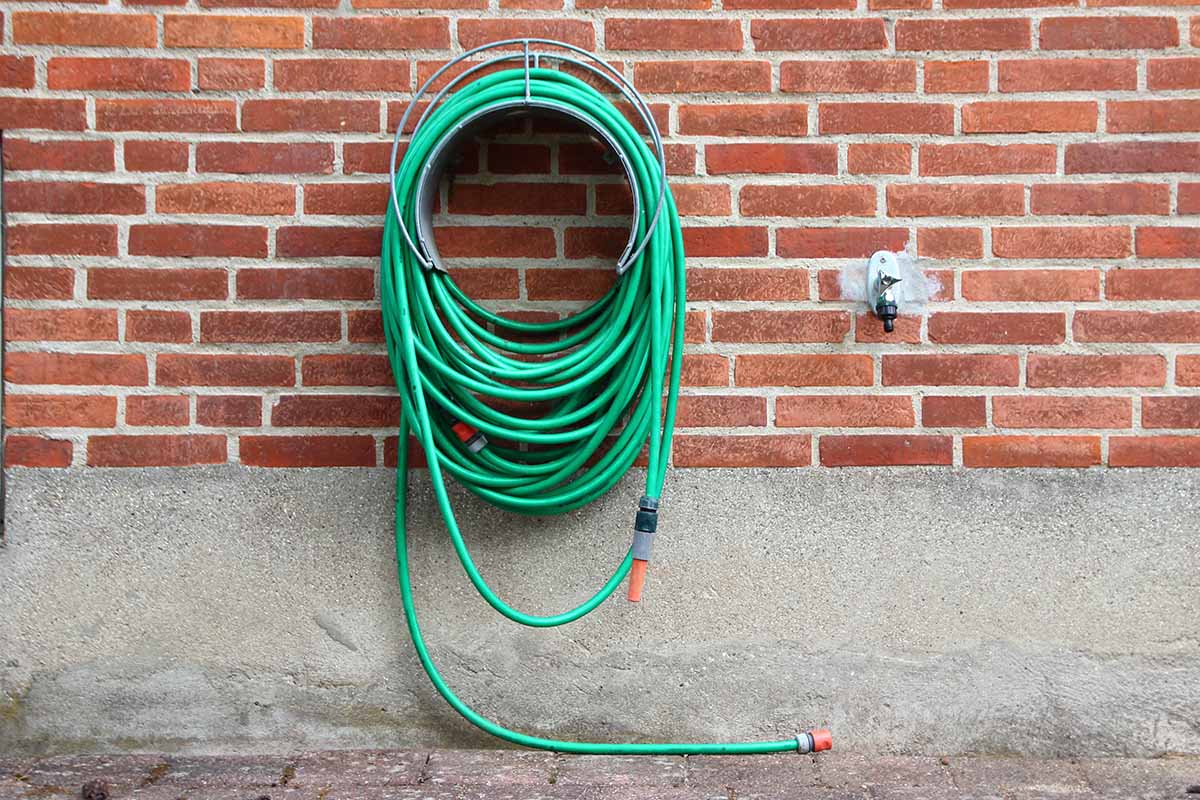
Most of the time, kinks happen by accident, but sometimes they may be intentional. Heck, I’ve been guilty of purposely putting a sharp crease in a hose so that I stay dry while changing out sprinkler heads or nozzles.
While it can save you time and water, this habitual kinking will eventually leave the tubing with a hole where the kink used to be.
Resist the temptation to kink the tubing at the end, and always turn the water on or off by using the faucet. I know the long trek back to the faucet is a hassle, but so is a ripped garden hose… I’m speaking to my past self on this one.
Of course, you could always just use a hose nozzle, which will only let water out when you pull the trigger. From long, shower-head wands to sidearm-sized ones with multiple spray settings, options abound.
Alternatively, you could invest in a few quick-change adapters to save endless trips back and forth across the yard.
Adapters easily attach to nozzle ends and sprinkler heads, and pop apart quickly when it’s time to change sprinklers. They also have a baffle inside of them that shuts off the flow of water, making the task of switching out sprinklers a breeze.
I’d really suggest springing for brass adapters, as they typically last much longer than the plastic ones – those tend to last a couple of weeks to several months before developing issues.
Check out this brass set of quick connectors, offered by Nelson via Amazon.

This probably goes without saying, but be mindful of your hose when laying it out across a driveway or street. I wouldn’t make a habit of driving over one with your vehicle, especially not while the water’s running.
Make sure to be extra cautious with the connections, too, as they likely won’t survive a single automobile flattening.
The sun is also a potential threat to keep in mind. Over time, the ultraviolet rays of the sun can distort, damage, and disintegrate a garden hose.
A sun-damaged tube can develop warps and bulged areas that look like a snake swallowing an orange.

Therefore, a hose should be shielded from the sun whenever it’s not in use. In a shed, beneath an awning, or even under a designated hose cover.
The cover doesn’t have to be anything special, but it must provide total blockage from the sun.
However, I believe in form following function, and a holder such as a shaded reel or covered pot can be a stylish means of sun shielding.
For a container that looks like it could hold a snake charmer’s cobra just as easily as a garden hose, CobraCo offers a copper-finished holder, emblazoned with images of stylish birds and flowers.

Bird Motif Copper Finish Hose Holder with Lid
If you’re interested, it’s available from Amazon.
Before storing you should also make sure to drain away any sitting water, as it can promote the growth of pathogens and degrade the inner tube.
Plus, come winter, sitting water can expand and rupture the tube from the inside.
To drain the hose, angle it along a downward-facing slope so gravity can do all the work.
Fixing Garden Hose Damage
Near the sprinkler section of your favorite home improvement store, you may have noticed a large shelf stocked with hose repair components.
No matter how bad the mangling, there’s probably a kit available to repair it.

Kits generally cover three basic areas: replacements for the nozzle end, replacements for the receiving end, and a way to splice and mend a leak in the middle.
Repair kits tend to be pretty inexpensive and easy to use, often requiring nothing more than a screwdriver and a sharp knife.
Repairing a hose is far less expensive than buying a new one, and when done properly, it can extend its life for a while longer.
Once again, opt for aluminum or brass rather than cheap plastic. Also, be sure that you order the correct kit, size-wise.

Aluminum Repair Kit with Clamps
Here’s an aluminum repair kit for a 5/8-inch hose, sold by Orbit on Amazon.
Need a New One? What to Look For
Aside from adequate care and maintenance, selecting a high-quality garden hose that meets your needs will ensure that it lasts for a good long while.
When considering durability for the long haul, it’s worth keeping materials and the degree of reinforcement in mind.
The right material can make all the difference, believe me. The stronger the material, the less maintenance and babying it needs. A strong material will last longer, all else kept equal.
Typically, hoses are made of vinyl, rubber, polyurethane, or metal.
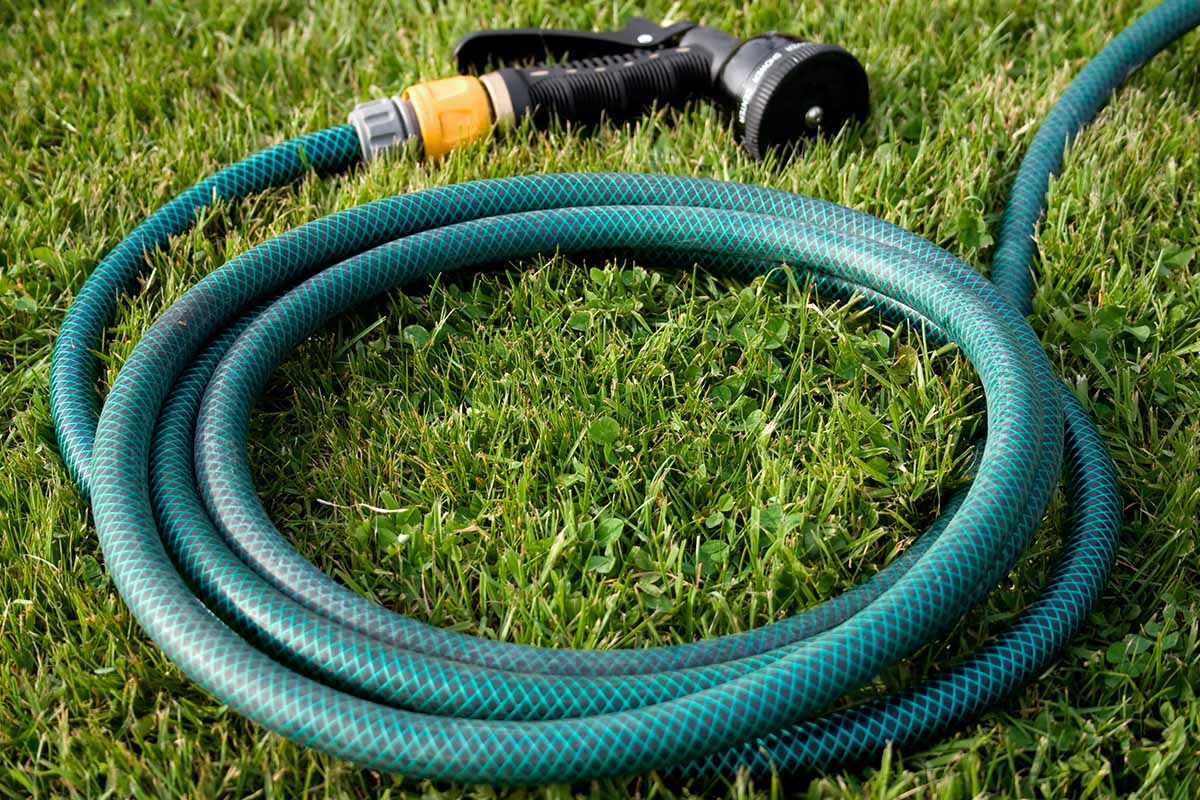
Vinyl is cheap and lightweight, but it is the least durable material.
You can easily move vinyl around without much strain, but you’ll have to be extra careful to protect it from sun degradation and kinking.
However, I would be remiss if I failed to mention the toxic chemicals that disintegrating vinyl can leach into water.
Rubber is pretty tough, with ample resistance to kinking and sun deterioration. However, its heavy weight can be a real pain to lift and maneuver.
Polyurethane is lighter than rubber and even more flexible than vinyl, but it has a low water pressure limit, or psi rating. Plus, this type can cost a pretty penny.
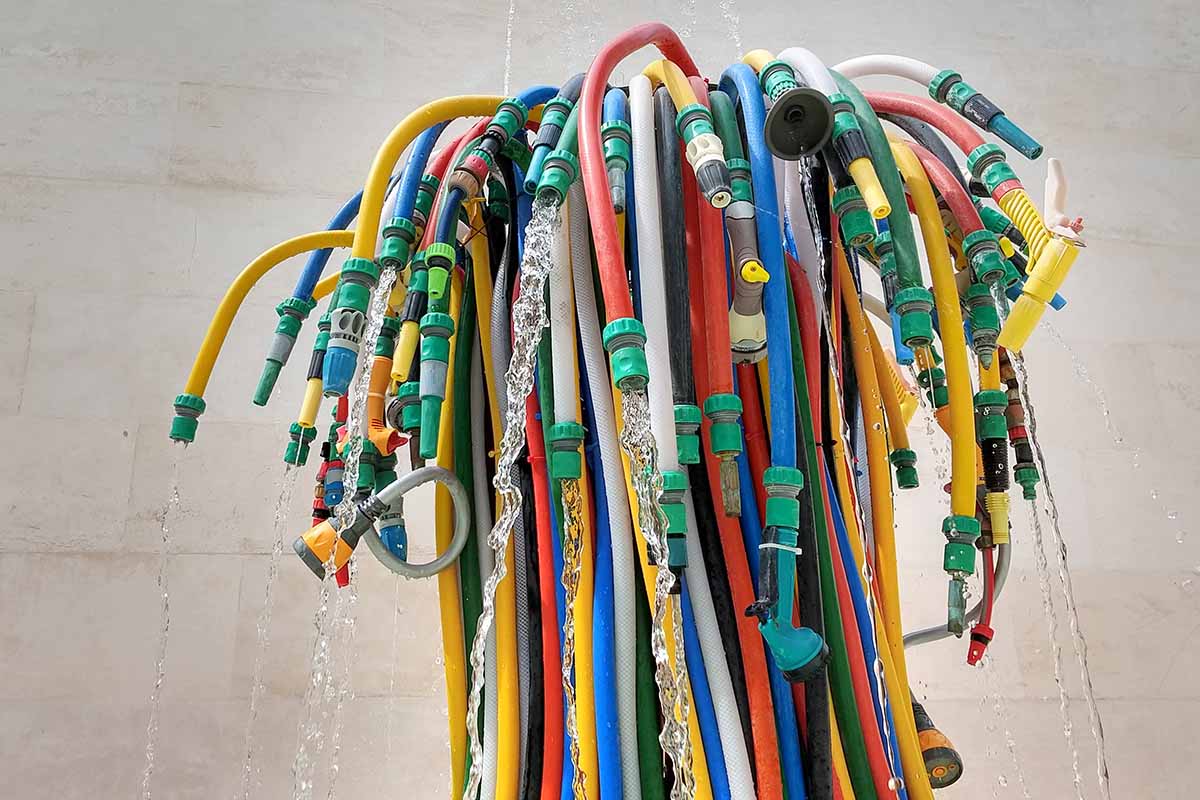
Metal is actually pretty overpowered in the strength department.
Lightweight, ultra tough, and with no risk of kinking, it can be left outside in the elements year-round, needing no coddling whatsoever. But it often has a low psi rating and limited water flow.
Like tissues or toilet paper, hoses are often reinforced with multiple layers, or plies.
The more plies, the stronger the tubing. The stronger the tubing, the less susceptible it is to damage, and the longer it will last.
But at the end of the day, you have to make sure you’re satisfied with the usability. There’s no use in having an indestructible hose if you hate to hold and move it, you know what I mean?
The Hose Knows
It’s true. In terms of how it’s been treated, your hose keeps the score.
A kinked-up, distorted, or torn one indicates neglect, whereas one that’s pristine, undamaged, and otherwise attractive says a lot about a gardener’s care.
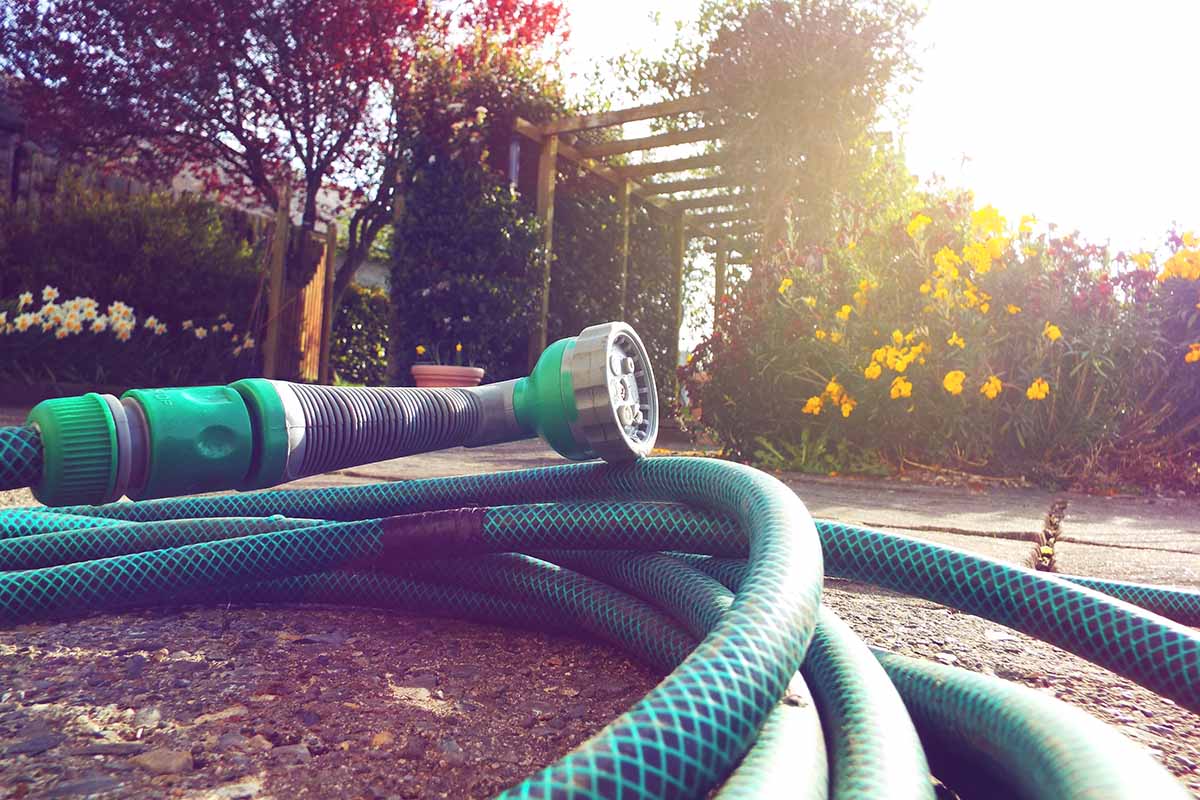
With the above tips, you can keep your hose poppin’ – in a figurative, slangy sort of way, of course. Actual poppage is a sign of a rupture, which should be taken care of ASAP.
Questions, comments, other tips I should have included? Put it all in the comments section below!
Seeking other handy gardening equipment tutorials? If I could direct your attention below…